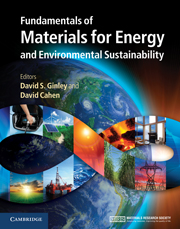Book contents
- Frontmatter
- Contents
- Contributors
- Preface
- Acknowledgments
- Part 1 Energy and the environment: the global landscape
- Part 2 Nonrenewable energy sources
- Part 3 Renewable energy sources
- Part 4 Transportation
- 31 Transportation: motor vehicles
- 32 Transportation: aviation
- 33 Transportation: shipping
- 34 Transportation: fully autonomous vehicles
- Part 5 Energy efficiency
- Part 6 Energy storage, high-penetration renewables, and grid stabilization
- Summary
- Appendix A Thermodynamics
- Appendix B Electrochemistry
- Appendix C Units
- Index
- References
33 - Transportation: shipping
from Part 4 - Transportation
Published online by Cambridge University Press: 05 June 2012
- Frontmatter
- Contents
- Contributors
- Preface
- Acknowledgments
- Part 1 Energy and the environment: the global landscape
- Part 2 Nonrenewable energy sources
- Part 3 Renewable energy sources
- Part 4 Transportation
- 31 Transportation: motor vehicles
- 32 Transportation: aviation
- 33 Transportation: shipping
- 34 Transportation: fully autonomous vehicles
- Part 5 Energy efficiency
- Part 6 Energy storage, high-penetration renewables, and grid stabilization
- Summary
- Appendix A Thermodynamics
- Appendix B Electrochemistry
- Appendix C Units
- Index
- References
Summary
Focus
Shipping delivers huge numbers and amounts of goods to consumers worldwide, whether that be through container ships full of automobiles, tankers full of oil, or trawlers full of fish. Despite being such a central component of the global economy, shipping is not regulated by the Kyoto Protocol, and recent studies project that shipping will produce between 400 Mt and 1.12 Gt of CO2 by 2020, which would be more than aviation and up to 4.5% of global CO2 (http://www.guardian.co.uk/environment/2008/feb/13/climatechange.pollution). This chapter focuses on the need for shipping to change in a carbon-sensitive world and possible changes that would allow shipping to reduce its environmental impact while still delivering increasing amounts of goods efficiently worldwide.
Synopsis
Since oceans cover approximately 70% of the Earth's surface, the development of shipping was inevitable. In addition to allowing human communities on different land masses to engage in the crucial activity of trading commodities such as spices and gold, shipping nucleated the cross-fertilization of groups by transporting people as well. These activities have grown over time to the point that shipping now transports over 90% of the total goods worldwide. In fact, this amount is still growing as international trade continues to expand [1].
- Type
- Chapter
- Information
- Publisher: Cambridge University PressPrint publication year: 2011



